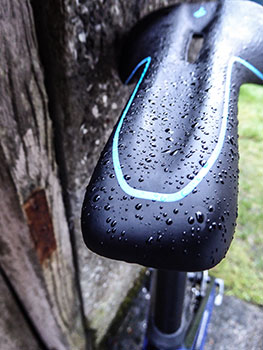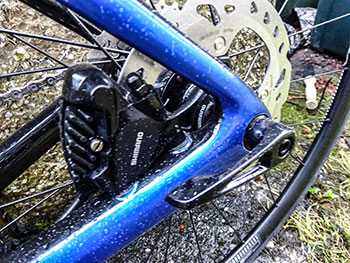
..........................................................................................................................................................................................................
specialized roubaix comp

paris-roubaix is the highlight of the season as far as i'm concerned including, bygone days of oddly shaped treks, suspension bianchis and rock shox roubaix front forks none of which, if memory serves, offered much in the way of assistance to those keen to win a cobble for the mantlepiece. that, however, hasn't prevented specialized from building bicycles named after the race, with some form of springy bits to aid not only those who actually race from compiegne to roubaix, but the rest of us who like to think we could.

for 2017, gone are the zertz inserts about which i've always held suspicions, to be replaced with a slightly springy seatpost and an adjustable springy stem. the latter consists of a cartridge sat atop the steerer, inside which is a real, live spring. or potentially, three different springs, coloured black, blue or yellow. the stiffest version is factory fitted, but replacing it in order to find the most appropriate for your needs is a simple process. the stem cap is, in fact, not really a stem cap in the manner to which we have become accustomed. the centre-bolt is, in fact, a little screw, tightening of which has no effect on the headset whatsoever. it merely screws into the top of the spring cartridge. removing this and the stem reveals the latter; to replace the spring, it's a simple case of unscrewing the top with a 20mm cone spanner, removing the existing spring and popping in your choice of suspension.

headset adjustment is distinctly non-standard, effected by means of tiny allen bolts on each side of the steerer. by inserting a 2.5mm allen wrench and loosening the bolts, it's then a matter of inserting a 2mm allen wrench to tighten the lower allen bolts. those press down on the upper bearing race, thus tightening the headset. all this is covered by what i can only refer to as the headset cover which sits in a scalloped cutout on the head tube. if you'd like to alter the stack height, there's a spare, differently sized cover along with the spare springs. i didn't alter the stack height during the review period as the factory setting suited just fine.

aside from the springy stem and headset region, the carbon frame is very similar to that of several other specialized models, though there has been a somewhat odd change made to the seatpost clamp. instead of an external aluminium, single-bolt clamp, there are now two allen bolts towards the middle of the seat tube, just under the top tube and pretty much where the seatstays join the main triangle. both of these bear torque settings and have need of being equally tensioned. however, i'm really not in the habit of carrying a torque wrench with me when i go cycling and i can't see what was wrong with the one-bolt system it replaces.
nonetheless, i cannot deny that in practice, it works just fine.
the sloping-topped carbon frame features specialized's almost trademark three bottle bosses on the down tube, allowing variable cage placement, with a further two bosses on the seat tube. the cabling from the shimano ultegra hydraulic disc brakes and the mechanical shifters are all internally routed, including that for the front disc, which runs inside the left fork leg. bars and stem are both from the specialized cupboard as is the very comfortable bar tape, while the ultegra levers incorporate the hydraulic cylinders, offering an extra hand-position when on the hoods.

the wheels feature the same dt swiss tubeless-ready rims as found on the specialized crux, but strangely are shod with 26mm specialized rubber as opposed to the 28mm on some of its more expensive brethren. in keeping with the majority of today's disc wheels, the forks are formed for thru-axles, but in an odd variation from those on the crux, the axle levers are not ratcheted, meaning that they sit at whatever angle they end up, no matter how ungainly that looks.
i figure velominati will have something to say about that.

though front and rear mechs are sourced from shimano's ultegra groupset, the rear married to an 11-32t 105 cassette, the compact alloy chainset (50/34), however, is badged praxis works zayante, supported by external bearing cups as opposed to the more common press-fit. i for one prefer the former to the latter. though probably remarkably common, i really hadn't noticed that the front disc is 160mm while the rear is only 140mm, no doubt specced to balance out the impressive braking power. the saddle is one of specialized's excellent phenom models with a slot in the middle.
going for a ride

i have ridden enough bicycles from the specialized stable to know just how good their carbon frames truly are. i still figure their crux elite cross bike is the best i've ever ridden, so if we can take that part as read, what we're all desperate to know is just how effective the sprung stem really is. i figured the only way to reveal that part was to head straight for the abbatoirenberg forest road, one of islay's most atrocious amalgamation of patchwork tarmac.
in years past i have actually ridden a section of paris-roubaix cobbles, an experience that was hugely enjoyable, but gave the impression that the headset was intending to depart the head tube at any moment. the chattering noise emanating from the roubaix over islay's rough stuff was highly reminiscent of riding the roubaix cobbles. so much so, in fact, that i was sure the headset had possibly not been correctly set prior to being sent from the manufacturer (i was wrong). the accompanying bouncing from the stem and bars did nothing to alter that thought.

however, after a kilometre or so, you begin to get the hang of what the suspension can achieve and to incorporate the chattering noise into the reality of an enhanced bike ride. hebridean singletrack more often than not, is peppered with cattle grids; join those with a crap road surface and the joys of a moderately sprung seatpost and bars begin to make a lot of sense.
over the course of the review period, i switched between all three springs, and though there's not a whole lot of difference between them, the middle weight suited me best, even though it chattered more than the stiffest, but not nearly as much as the lightest. it would be nice if there was some form of manual lock-out, because it's not always necessary to bounce and there is a smidgeon of bobbing experienced when climbing out of the saddle.
suspension aside, however, the roubaix does not disappoint. yes, with an alloy chainset and disc brakes, it's definitely not the lightest machine i've ever ridden, but in practice, that's a tad academic. few of us spend our weekends on the ventoux or alpe d'huez and it would be a tad iniquitous to think a bicycle named after paris-roubaix would suit the intrepid grimpeur. that said, it's no slouch when the road goes up and the frame has a chuckability rating that would bring a smile to the face of most riders.

and if it goes up fairly well, it goes down even better, exhibiting the sort of stability that would account for the descending bravado exhibited by vincenzo nibali. however, as the name would imply, it's finest hour is being thrown about on the very worst of roads. yes, the same level of comfort and insulation can be experienced from the saddle of a crux but probably not at the sort of speeds a narrower set of road tyres will allow.
it would be less than revelationary to state that shimano's gear changing lived up to expectations and the stopping power offered by the hydraulic discs was most welcome, particularly when a tractor sneaked out from the rspb reserve as i accelerated downhill (i'm not sure who got the bigger fright). oddly enough, the sram rival discs on the crux behave almost silently in the wet, while shimano's ultegras on the roubaix emitted an embarrassing howl when even mildly damp. ah, the vicissitudes of technological advancement.

i will cheerfully confess that my first few rides, though pleasant enough, did not have me convinced that the roubaix suspension was something that would rock my world. however, after switching to the mid-weight spring and getting into a roubaix groove, i'd be inclined to fight you for possession, such was the fun and excitement offered by the ride. however, the virtues of its versatility do not stop there.
i have in the bikeshed a pair of challenge 700 x 33c strade bianche tyres which worked superbly on the crux during last august's ride of the falling rain, so i thought i'd try the same on the roubaix. unfortunately, i failed to have the front tyre seat properly on a wheelsmith disc front wheel; the tyre's fault, not the wheel. however, it was notable that there is in fact clearance available on the roubaix both front and rear for such large rubber, probably one of the few road frames to offer as much.

having failed with the 33mm rubber, i fitted a set of challenge 700x28c paris-roubaix tyres to the wheelsmiths subsequently creating possibly one of the world's finest bicycles to trammel over trashed road surfaces. there's just something about handbuilt wheels...
there are more expensive versions of the roubaix - a member of the velo club peloton currently owns a £6,000 roubaix pro - but to my mind, the £2650 roubaix comp offers everything i figure i'll ever need from such a bicycle. the suspension may come across as a bit of a marketing gimmick (paris-roubaix has been won many, many times without springs), but even if that is even partially true, its benefits were more than welcome for removing the sting engendered by unkempt roads. granted, its blue/black colour scheme doesn't change colour when the sun comes out, but boy is it great fun.
sunday 9 april 2017
 ..........................................................................................................................................................................................................
..........................................................................................................................................................................................................